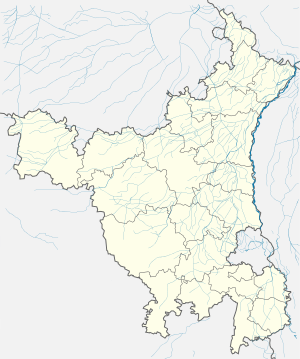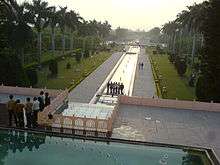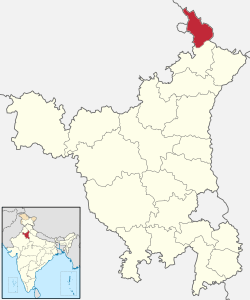Pinjore
| Pinjore | |
|---|---|
| City | |
|
| |
 Pinjore Location in Haryana, India  Pinjore Pinjore (India) | |
| Coordinates: 30°47′50″N 76°55′02″E / 30.7972°N 76.9172°ECoordinates: 30°47′50″N 76°55′02″E / 30.7972°N 76.9172°E | |
| Country |
|
| State | Haryana |
| District | Panchkula |
| Population (2011)[1] | |
| • Total | 35,912 |
| Time zone | UTC+5:30 (IST) |
| ISO 3166 code | IN-HR |
| Vehicle registration | HR-03 |
| Website |
haryana |
Pinjore is a town in Panchkula district in the Indian state of Haryana. This residential 'township', located close to Chandigarh, is set over 1,800 feet above the sea level in a valley, overlooking the Sivalik Hills. Pinjore is known for Pinjore Gardens, Asia's best 17th Century Mughal garden,[2] and the Hindustan Machine Tools (HMT) factory.
Demographics
As of 2011 India census,[3] Pinjore had a population of 35,912. Males constitute 54% of the population and females 46%. Pinjore has an average literacy rate of 76%, higher than the national average of 59.5%: male literacy is 80%, and female literacy is 72%. In Pinjore, 13% of the population is under 6 years of age. Hindi & Punjabi are major languages
Climate
The average temperatures for summers and winters are 35 and 18 degree Celsius respectively, with rainfall concentrated over the summer months of July, August and September.
Pinjore Garden

Pinjore Gardens, also called Yadavindra Gardens, represent one of the most travelled excursions from Chandigarh. Located at Pinjore, in the state of Haryana, they fall at a distance of about 22 km from the 'City Beautiful', on the Chandigarh-Kalka Road. The gardens lie at the foothills of the lower Shivalik ranges and stands as an apt example of the Mughal Garden style. Spread over an area of 100 acres, Pinjore Garden serve as the venue of the annual Mango Festival. The gardens house a mini zoo, historic places, Japanese garden, nursery and a number of picnic spots. According to the Hindu Mythology, the Pandava Brothers rested here during their exile.
History Early in the 17th century, Nawab Fidai Khan, a reputed architect and the cousin of Mughal Emperor Aurangzeb, made the design for the Pinjore Gardens. At that time, the Nawab was the Governor of the Province and during one of his tours, he happened to visit the Pinjore valley. He was so enchanted with the beauty of the place that he thought of making a beautiful garden there and this is how the concept of the gardens came into being. The Nawab designed the garden as per the classical Charbagh pattern and introduced a central waterway in the area. He planned both sides of the waterway to be planted with the patches of green bordered with flowers, along with cover the entire place with a number of trees, like traditional palm, cypress and magnolia.
While Pinjore Gardens were still being created, goiter struck the women of the place. The courtiers of the Nawab immediately left the place, which forced him to quit as well. The palace later fell first under the reign of Raja of Sirmaur and finally, in 1775 AD, under Maharaja Amar Singh of Patiala. The latter consolidated Pinjore to his lands. He had a great admiration for the beauty engulfed in the garden and used to visit the place frequently. Amar Singh is credited with to improve the garden manifold. In 1966, Haryana was declared as an independent state and Pinjore Garden was handed over to it. Today, the garden continues to be one of the prime attractions of Haryana.
Features Pinjore Garden is built in the typical Mughal style. It has a sloping ground and is adorned with fountains and grand pavilions. However, it differs from the other Mughal Gardens in respect that the seven terraces at Pinjore, instead of ascending, descend into a distance, creating a magical sight. The garden is full of varied species of beautiful, aromatic flowering plants, big trees, mango orchards, litchi orchards and several shrubs. The garden presents cool, shady walks and flagged pathways, which run to the reaches of the creeper-covered walls.
Recently, the end structure of the doorway was made into a disc-like open-air theatre. The stiff outer wall of the garden is suggestive of the fort walls, which has now all around dieter pavilions housing the zoo. A watercourse traipsing from level to level sparkles in the sunlight, its pools reflecting white shining pavilions and balconies etched high against a blue sky. The stylishly arched balconies and shining fountains, luxuriant green lawns and murmuring watercourse, limpid pools, shady walks and colorful flowerbeds, unusual descending terraces and monumental gateways - all are carefully planned to give the magic effect.
Besides the greenery and nature, one can find other attractions within Yadavindra Gardens, like a mini zoo, historic places, Japanese garden, nursery, and a number of picnic spots. The gardens are brightly illuminated at night. There is a Jalmahal within the garden, which is presently used as a restaurant. The garden is open from 7am to 10pm. The entry ticket for the garden is Rs.20 per head. Special programs are organized in the garden during the festivals, like Baisakhi and Mango Festival, which attract visitors from every corner of the country.
Bhima Devi temple
There is an ancient temple adjoining Pinjore gardens. The temple is named Bhima Devi Temple Site Museum. It consists of various erotic statues of ancient deities. The temple contains some statues of Lord Shiva in his Nataraja form. The temple has been made into an open air museum acceccible to public. No ticket is required for entering the temple. It was constructed between 8th and 12th century AD. It is under protection of Haryana government.[4]
Kaushalya dam
Kaushalya Dam is an earth-filled barrage dam on Kaushalya river in Pinjore. It is an important wetland that is home of many endangered migratory birds.[5]
Transportation
Air
The nearest international airport is Chandigarh Airport and Indira Gandhi International Airport, New Delhi. Chandigarh is a 50-minute flight from Delhi.
Road
Pinjore can be reached by road from Delhi via the Sonepat Bypass.
Volvo Coach, Deluxe, Semi-Deluxe and Express buses are also available from Inter-State Bus Terminal (ISBT), New Delhi to Chandigarh and vice versa every hour from 05:00 hrs to midnight. Ordinary buses ply every 10 minutes. Journey duration is 5 hours.
Rail
The Chandigarh/Kalka train stops in Kalka, and is a 4-hour journey from New Delhi.
Schools
- ST.Vivekanand Millennium school HMT township pinjore
- Ajad Public School
- Noble High School
- Alpine School
- Delhi Public School Society, Ishar Nagar, Himshikha[6]
- The Education Tree School, Pragati Vihar, Opp. Dharampur, Pinjore https://theeducationtreesc.wixsite.com/school
- JP Gurukul High School, Bitna colony
- New India Public School, Ratpur colony
- Paragon Public School, Shiv colony, Bitna road
- Sapient Public School
- JB Smart Kids Public School, Shiv Colony
Wildlife
The Indian Flying Fox can be seen at the Yadavindra Gardens enclosure and entrance. Hundreds of these bats can be seen roosting during the day in the taller trees in the compound. At the border which divides Kalka-Pinjore Indian peafowl can be seen in the woods during monsoon season.
Jatayu Conservation Breeding Centre
Jatayu Conservation Breeding Centre, Pinjore is a breeding centre for the critically endangered Indian vulture. It is present within Bir Shikargah Wildlife Sanctuary.[7][8].
Bir Shikargah Wildlife Sanctuary
Bir Shikargah Wildlife Sanctuary is a wildlife sanctuary present in Pinjore spread over an area of 767.30 hectares (1,896.0 acres). It also houses Vulture Conservation and Breeding Centre. It contain a number of animals including Indian leopard, Asiatic elephant, Chital (spotted deer), Sambar deer, Wild boar, Rhesus macaque, Gray langur, Striped hyena, Indian jackal, Jungle cat, Indian gray mongoose, Indian fox and Indian jackal.[9] [10]
See also
References
- ↑ "Census of India Search details". censusindia.gov.in. Retrieved 10 May 2015.
- ↑ https://books.google.com/books?id=TVXCiwdwPxsC&pg=PA134&dq=Ambala+scientific+instruments&hl=en&sa=X&ei=reOBUZT9Mc7q0QHX5ICoAg&ved=0CFoQ6AEwCQ#v=onepage&q=Ambala%20scientific%20instruments&f=false
- ↑ "Census of India 2001: Data from the 2011 Census, including cities, villages and towns (Provisional)". Census Commission of India. Archived from the original on 2004-06-16. Retrieved 2008-11-01.
- ↑ http://www.haryanatourism.gov.in/Destination/bhima-devi-temple
- ↑ Title: Crows drop dead, Newspaper: Times Of India, Published: 22 December 2014, Accessed: 26 March 2016
- ↑ http://www.dpspinjore.com
- ↑ https://web.archive.org/web/20140512232130/http://haryanaforest.gov.in/protect.aspx
- ↑ News article about endangered species of vulture https://timesofindia.indiatimes.com/city/chandigarh/centre-clears-way-for-satellite-tracking-of-endangered-pinjore-vultures/articleshow/57741692.cms
- ↑ Government of India's Ministry of Environment and Forests clearance, published: 2013
- ↑ https://web.archive.org/web/20140512232130/http://haryanaforest.gov.in/protect.aspx
